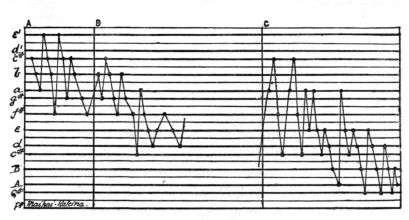Traditional Hopi Songs - online book
Native American Songs With Sheet Music, Notation & Commentary
| Share page | Visit Us On FB |
|
MAIHA1-KA TCINA |
167 |
||
|
COURSE OF TONE: MAIHAI-KATCINA, Concluded Jfe&uL. |
|||
 |
|||
|
Argument. A theme based on a tetrachord (d'-c'd'-b-a) is repeated after an interlude, the tetrachord expanded to a tetrad (d'e'-c'd'-b-ga) ; and after a finale the strophe is repeated, the tetrachord and tetrad changing places, the interlude contracted and the finale contracted at the opening, expanded at the close, and repeated, further expanded, with a coda. |
|||
|
Gay follows grave in this song as light chases shadow over a landscape. Like the preceding it presents an intricate rhythm of major and minor versions of its three segments, indicated unmistakably but by novel and subtle features.
The main movements of A4 and the initial movement of A1 are of less span than those of A2 and A3; the remaining wider movements of A1 giving it the ambiguity noted before in initial segments. The second and third salient movements of B are both ampler in B1 than in B2; the final major thirds, fg-d in B1, g-de in B2, are divided higher in B1, and the curious alternation of pitch at the close of B1 before the leap to A2, which is major, ends in a seventh tone rise, while the similar movement in B2 before the leap to A4, which is minor, ends in a seventh tone fall. Similar differences exist in the C's, differently combined for new reasons. The opening three movements of C1 following A2 (major) are wider than those of C2 following A4 (minor); |
|||